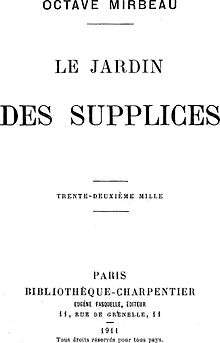The Torture Garden
The Torture Garden (French: Le Jardin des supplices) is a novel written by the French journalist, novelist and playwright Octave Mirbeau, and was first published in 1899 during the Dreyfus affair. The novel is dedicated: "To the priests, the soldiers, the judges, to those people who educate, instruct and govern men, I dedicate these pages of Murder and Blood."
 | |
| Author | Octave Mirbeau |
|---|---|
| Original title | Le Jardin des supplices |
| Country | France |
| Language | French |
| Genre | Decadent novel |
| Publisher | Fasquelle |
Publication date | 1899 |
Plot summary

Published at the height of the Dreyfus affair, Mirbeau's novel is a loosely assembled reworking of texts composed at different eras, featuring different styles, and showcasing different characters. Beginning with material stemming from articles on the 'Law of Murder' discussed in the "Frontispiece" ("The Manuscript"), the novel continues with a farcical critique of French politics with "En Mission" ("The Mission"): a French politician's aide is sent on a pseudo-scientific expedition to China when his presence at home would be compromising. It then moves on to an account of a visit to a Cantonese prison by a narrator accompanied by the sadist and hysteric Clara, who delights in witnessing flayings, crucifixions and numerous tortures, all done in beautifully laid out and groomed gardens, and explaining the beauty of torture to her companion. Finally she attains hysterical orgasm and passes out in exhaustion, only to begin again a few days later ("Le Jardin des supplices", "The Garden").
Commentary

There is an allegory about the hypocrisy of European 'civilisation' and about the 'Law of Murder'. There is also a denunciation of bloody French and British colonialism and a ferocious attack on what Mirbeau saw as the corrupt morality of bourgeois capitalist society and the state, which he believed were based on murder.
But Mirbeau's multiple transgressions of the rules of verisimilitude and his disregard for novelistic convention confuse the issue of the novel's genre affiliation and leave open the question of the author's moral message, leaving the readers of today in a state of wonderment, perplexity, and shock.
Quotes
- Woman possesses the cosmic force of an element, an invincible force of destruction, like nature's. She is, in herself alone, all nature! Being the matrix of life, she is by that very fact the matrix of death - since it is from death that life is perpetually reborn, and since to annihilate death would be to kill life at its only fertile source. ~"The Manuscript"
- To take something from a person and keep it for oneself: that is robbery. To take something from one person and then turn it over to another in exchange for as much money as you can get: that is business. Robbery is so much more stupid, since it is satisfied with a single, frequently dangerous profit; whereas in business it can be doubled without danger. ~"The Mission," Chapter 2
- There is only one trait which is irreparable in a statesman: honesty! Honesty is negative and sterile; it is ignorant of the correct evaluation of appetite and ambition - the only powers through which you can found anything durable. ~"The Mission," Chapter 3
- You're obliged to pretend respect for people and institutions you think absurd. You live attached in a cowardly fashion to moral and social conventions you despise, condemn, and know lack all foundation. It is that permanent contradiction between your ideas and desires and all the dead formalities and vain pretenses of your civilization which makes you sad, troubled and unbalanced. In that intolerable conflict you lose all joy of life and all feeling of personality, because at every moment they suppress and restrain and check the free play of your powers. That's the poisoned and mortal wound of the civilized world. ~"The Mission," Chapter 8
- Alas, the gates of life never swing open except upon death, never open except upon the palaces and gardens of death. And the universe appears to me like an immense, inexorable torture-garden. Blood everywhere and, where there is most life, horrible tormentors who dig your flesh, saw your bones, and retract your skin with sinister, joyful faces. ~"The Garden," Chapter 9
- Ah, yes! the Torture Garden! Passions, appetites, greed, hatred, and lies; law, social institutions, justice, love, glory, heroism, and religion: these are its monstrous flowers and its hideous instruments of eternal human suffering. What I saw today, and what I heard, is no more than a symbol to me of the entire earth. I have vainly sought a respite in quietude and repose in death, and I can find them nowhere. ~"The Garden," Chapter 9
Translations
- The first Spanish translation, by Ramon Sempau and C. Sos Gautreau, is of 1900 (El Jardín de los suplicios, Barcelona, Casa Editorial Maucci).
- The book was translated into English and published in 1903[1].
- The Italian translation of Jardin des supplices, by Decio Cinti, is of 1917 (Il Giardino dei supplizi, Milan, Sonzogno).
References
- Robert Ziegler, "Something from nothing : regenerated narrative in Mirbeau's Le Jardin des supplices", The Romanic Review, November 1, 1994
- Witchard, Anne (2015). "Gardens in Literature". British Modernism and Chinoiserie. Edinburgh University Press.
External links
- Octave Mirbeau, Le Jardin des supplices available at Éditions du Boucher (in French)
- Pierre Michel's foreword. (in French)
- Tom McCarthy, Introduction to The Torture Garden, Bookkake, 2007.
- Robert Ziegler, « Utopianism and Perversion in Mirbeau's Le Jardin des supplices », 2004.
- Translation and commentary of the rat torture scene in Le Jardin des supplices.